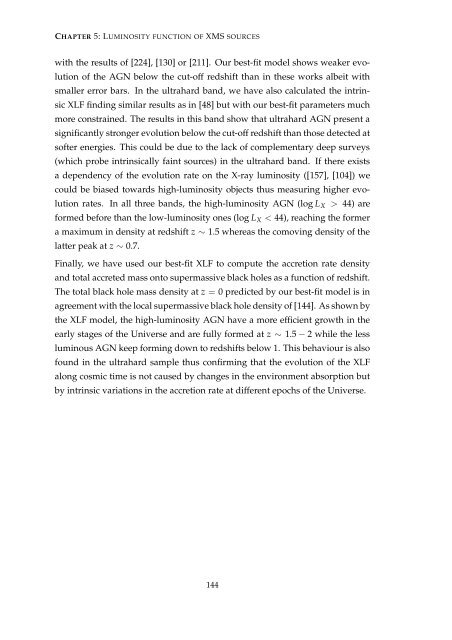pdf - SRON
pdf - SRON
pdf - SRON
You also want an ePaper? Increase the reach of your titles
YUMPU automatically turns print PDFs into web optimized ePapers that Google loves.
CHAPTER 5: LUMINOSITY FUNCTION OF XMS SOURCES<br />
with the results of [224], [130] or [211]. Our best-fit model shows weaker evolution<br />
of the AGN below the cut-off redshift than in these works albeit with<br />
smaller error bars. In the ultrahard band, we have also calculated the intrinsic<br />
XLF finding similar results as in [48] but with our best-fit parameters much<br />
more constrained. The results in this band show that ultrahard AGN present a<br />
significantly stronger evolution below the cut-off redshift than those detected at<br />
softer energies. This could be due to the lack of complementary deep surveys<br />
(which probe intrinsically faint sources) in the ultrahard band. If there exists<br />
a dependency of the evolution rate on the X-ray luminosity ([157], [104]) we<br />
could be biased towards high-luminosity objects thus measuring higher evolution<br />
rates. In all three bands, the high-luminosity AGN (log L X > 44) are<br />
formed before than the low-luminosity ones (log L X < 44), reaching the former<br />
a maximum in density at redshift z ∼ 1.5 whereas the comoving density of the<br />
latter peak at z ∼ 0.7.<br />
Finally, we have used our best-fit XLF to compute the accretion rate density<br />
and total accreted mass onto supermassive black holes as a function of redshift.<br />
The total black hole mass density at z = 0 predicted by our best-fit model is in<br />
agreement with the local supermassive black hole density of [144]. As shown by<br />
the XLF model, the high-luminosity AGN have a more efficient growth in the<br />
early stages of the Universe and are fully formed at z ∼ 1.5 − 2 while the less<br />
luminous AGN keep forming down to redshifts below 1. This behaviour is also<br />
found in the ultrahard sample thus confirming that the evolution of the XLF<br />
along cosmic time is not caused by changes in the environment absorption but<br />
by intrinsic variations in the accretion rate at different epochs of the Universe.<br />
144
















